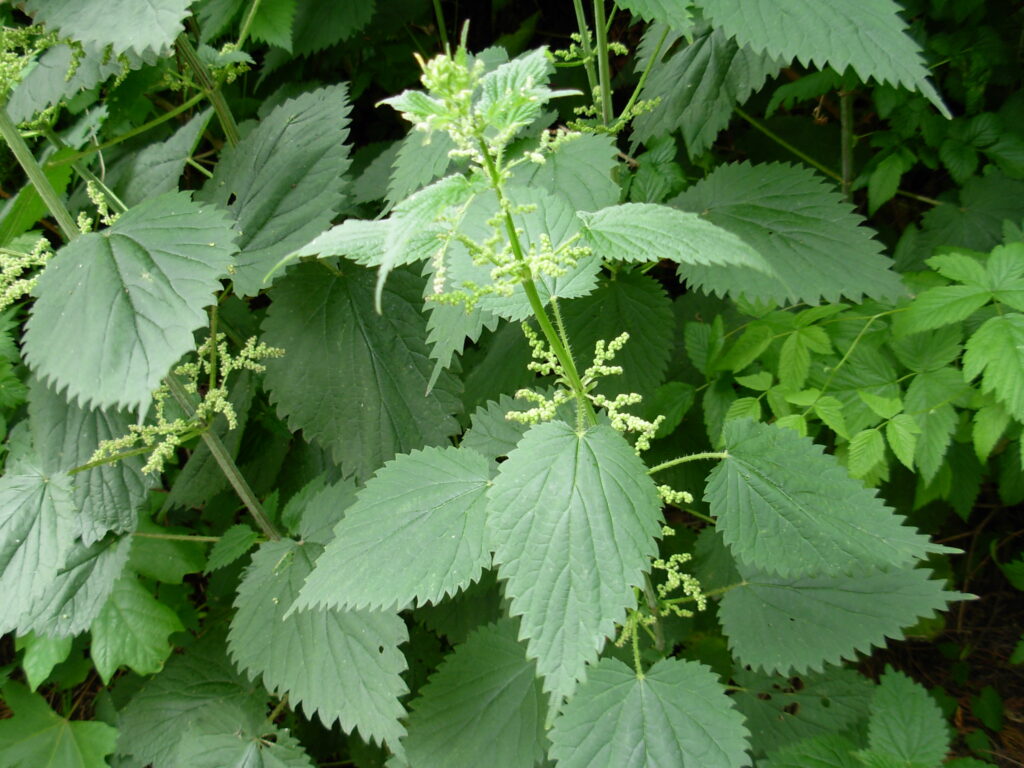My introduction to stinging nettle came in my youth when a group of us went swimming in a local farm pond. Instead of exiting the way I entered, I decided to climb up an unmown bank.
About 15 seconds later, my skin was on fire with an intense burning itch and little raised bumps. My cousin assessed the situation and announced I had gone through a stand of stinging nettle.
Stinging nettle (Urtica dioica) is a native herbaceous plant that grows along ditch banks, streambanks, and riverbanks across North America. It can also be found growing in wooded lowland areas and old farm sites. Its main identifying feature is its dark green lance-shaped leaves with tapering tips and serrated, toothed margins. It has small yellow or pink flowers near the top of the plant.
Stinging nettle spreads rapidly from underground stems called rhizomes, forming dense stands. These plants begin to grow in June. Typically, they are about 3-4 feet tall, but some can reach 8 feet tall by September. It grows in the wild in Asia, Europe, North America, and North Africa.
The leaves and stems of stinging nettle are covered with fine hairs called trichocysts. Each hair is a tiny hollow hypodermic needle filled with a mixture of acetylcholine, serotonin, formic acid, and histamines. When something brushes against the plant, the tips of the hairs break off and this irritating chemical mixture is ejected, causing a temporary skin rash.
Stinging nettle is a valuable food source for wildlife. Caterpillars of some butterflies feed on nettle, it is especially attractive to Painted Lady and Red Admiral butterflies. Birds like finches and juncos like to eat the seeds in the fall. Rabbits, deer, and mice are not slowed down by the stinging hairs of nettle. It is high in protein, vitamins, nutrients, and antioxidants; there are recipes for preparing nettles to add to pesto, salads, or to be eaten on its own.
Native Americans had multiple uses for stinging nettle. After the upright stems are stripped of leaves and hair, they can be peeled into strips and braided. When the braids dry out, they can be fashioned into a strong, durable fiber used to make baskets, fishing nets, and cloth. Dried leaves and roots were used to make medicine for urinary problems, seasonal allergies, ulcers, swelling, arthritis, and other ailments.
If you have an unfortunate encounter with stinging nettle, don’t panic. The stinging sensation is temporary and will go away by itself, usually within an hour.
If you can identify jewelweed (Impatiens capensis), a native plant often growing in the same habitat, you can crush its stems and leaves and rub the sap on the affected skin. Jewelweed contains an antihistamine that neutralizes the chemicals in stinging nettle. Native Americans used jewelweed mash to treat hives, insect stings, and plant allergies. Some herbalists use jewelweed extractions in compounds to treat poison ivy dermatitis as well. Jewelweed also has antimicrobial and antifungal properties, giving it a prominent place on Mother Nature’s pharmaceutical shelf.
Of course, the best way to mitigate the effects of stinging nettle is to avoid it. If you learn how to identify it, whether from a picture or by stepping in it, then you can gauge if there is a way to walk around it. Or, consider visiting a wider hiking trail. Sometimes wearing thick pants will help, but it is not unusual for the stinging hairs to go through clothing.
Instead of getting frustrated with the stands of stinging nettle you may find in the woods, remember how valuable it is to wildlife. An irritated leg is worth ensuring a forest is flourishing and full of food.
Sheryl Myers taught biology and environmental science for 34 years and has worked as a naturalist for area parks. She is a founding director of Red-tail Land Conservancy.




